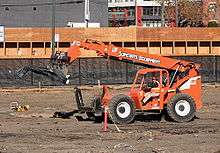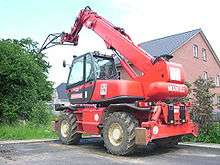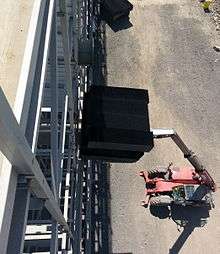Telescopic handler
.jpg)



A telescopic handler, also called a telehandler, teleporter, or boom lift, is a machine widely used in agriculture and industry. It is somewhat like a forklift but has a boom (Telescopic cylinder), making it more a crane than a forklift, with the increased versatility of a single telescopic or articulating boom that can extend forwards and upwards from the vehicle. On the end of the boom the operator can fit one of several attachments, such as a bucket, pallet forks, muck grab, or winch. Telehandlers are sometimes called cherry pickers in North America, as that name can refer to any truck or heavy equipment that has such a boom.
In industry the most common attachment for a tele-handler is pallet forks and the most common application is to move loads to and from places unreachable for a conventional forklift. For example, telehandlers have the ability to remove palletised cargo from within a trailer and to place loads on rooftops and other high places. The latter application would otherwise require a crane, which is not always practical or time-efficient.
In agriculture the most common attachment for a tele-handler is a bucket or bucket grab, again the most common application is to move loads to and from places unreachable for a 'conventional machine' which in this case is a wheeled loader or backhoe loader. For example, telehandlers have the ability to reach directly into a high-sided trailer or hopper. The latter application would otherwise require a loading ramp, conveyor, or similar.
The telehandler can also work with a crane jib along with lifting loads, that attachments that include on the market are dirt buckets, grain buckets, rotators, power booms. The agricultural range can also be fitted with three point linkage and power take-off. This makes the telehandler a truly universal piece of equipment.
The advantage of the telehandler is also its biggest limitation: as the boom extends or raises while bearing a load, it acts as a lever and causes the vehicle to become increasingly unstable, despite counterweights in the rear. This means that the lifting capacity quickly decreases as the working radius (distance between the front of the wheels and the centre of the load) increases. When used as a loader the single boom (rather than twin arms) is very highly loaded and even with careful design is a weakness. A vehicle with a 5,000 lb (2.5ton) capacity with the boom retracted may be able to safely lift as little as 400 lb (225 kg) with it fully extended at a low boom angle. The same machine with a 5,000 lb lift capacity with the boom retracted may be able to support as much as 10,000 lb (5ton) with the boom raised to 70°. The operator is equipped with a load chart which helps him determine whether a given task is possible, taking into account weight, boom angle and height. Failing this, most telehandlers now utilize a computer which uses sensors to monitor the vehicle, and will warn the operator and/or cut off further control input if the limits of the vehicle are exceeded, the latter being a legal requirement in Europe controlled by EN15000. Machines can also be equipped with front stabilizers which extend the lifting capability of the equipment while stationary, as well machines with are fully stabilised with rotary joint between upper and lower frames, which can be called mobile cranes although they can typically still use a bucket, and are also often referred to as 'Roto' machines. They are a hybrid between a Telehandler and small crane.
Telehandlers were pioneered by the Matbro company at Horley in Surrey, England, UK, which developed them from their articulated cross country forestry forklifts. At first they had a centrally mounted boom on the front section, with the driver's cab on the rear section, as in the Teleram 40, but the rigid chassis design with a rear-mounted boom and cab to the side has become more popular.
Manufacturers
- MST SANKO Company (Turkey)
- Bobcat (USA)
- Case IH (Italy)
- Caterpillar (USA) – See JLG.
- Xtreme Manufacturing (USA)
- Claas (Germany)
- Dieci (Italy)
- Deutz (Germany)
- Faresin Industries (Italy)
- Gehl (USA)
- Haulotte (France)
- Loadstar (India)
- MCE (Spain)
- JCB (England) An international company and major manufacturer of telescopic handlers, many of which are made in America.
- JLG SkyTrak and Lull (USA) a global aerial access equipment company and market leader in the USA. JLG has announced that its Lull telescopic handlers will be discontinued for 2015.[1]
- Kramer (Germany)
- Load Lifter Mfg (Canada)
- Mustang (USA)
- Magni (Italy)
- Manitou (France) under the 'Maniscopic' brand.
- Merlo (Italy)
- NC Engineering (Northern Ireland)
- New Holland (Italy)
- Pettibone Traverse Lift, LLC (USA)
- AUSA (Spain)
- Skyjack (Canada)
- Terex under the Genie brand.
- TOBROCO-GIANT under the TENDO brand (Netherlands)
- Weidemann (Germany)
No longer in Production
.
- Ingersoll Rand (USA) Purchased by Skyjack and no longer in production under the Ingersoll Rand name.
- Liner Concrete Machinery Company|Liner Giraffe (England)
- Matbro (England)
- Sanderson (England)
See also
References
External links
![]()